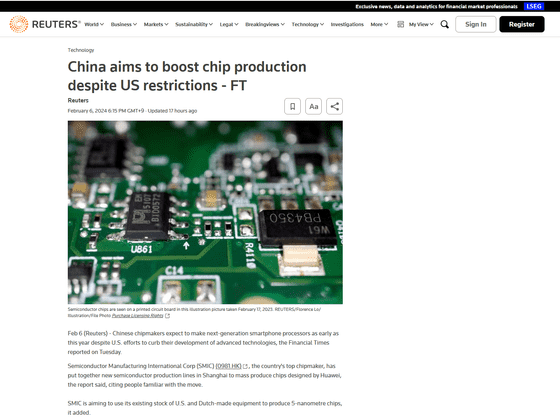Chinese semiconductor manufacturer SMIC reveals that it will overcome American regulations and manufacture 5nm process chips designed by Huawei's HiSilicon

As a result of the US-led economic sanctions that have continued since around 2019, China has fallen behind in semiconductor manufacturing technology compared to other countries. However, it has been reported that
China on cusp of next-generation chip production despite US curbs
https://www.ft.com/content/b5e0dba3-689f-4d0e-88f6-673ff4452977
China chipmaker SMIC on track to produce sanctions-busting 5nm processors for Huawei this year: Report | Tom's Hardware
https://www.tomshardware.com/tech-industry/semiconductors/chinas-smic-foundry-on-track-to-produce-5nm-smartphone-chips-for-huawei-this-year-report

China aims to boost chip production despite US restrictions - FT | Reuters

China's top chipmaker SMIC reports a 55% fall in quarterly net profit | Reuters
Smaller process nodes allow for more transistors on a chip, increasing performance and energy efficiency. Typically, extreme ultraviolet lithography (EUV) equipment is required to manufacture high-performance semiconductors such as 5nm processes. However, ASML, a Dutch manufacturer that handles EUV equipment almost exclusively, is prohibited from exporting EUV technology to China. Therefore, deep ultraviolet lithography (DUV) equipment is used in semiconductor manufacturing in China, and as a result, the performance of many semiconductors is limited to the 7nm process node.
Still, SMIC has built a new semiconductor manufacturing line at its Shanghai factory to mass produce 5nm process chips designed by its partner Huawei. Regarding the manufacturing of 5nm process chips, the overseas media Financial Times reports that ``SMIC was realized by using existing American and Dutch equipment.''
The 5nm process semiconductor manufactured by SMIC is expected to be used in the Kirin smartphone SoC developed by Huawei's subsidiary HiSilicon , as well as the Ascend 920 data center processor. This will significantly narrow the gap between high-performance chips developed by NVIDIA and others and Chinese alternatives.

On the other hand, it has been reported that SMIC's 5nm process semiconductors are expensive. According to people involved in Chinese fabless chips, the prices of SMIC's 5nm and 7nm process products are 40% to 50% higher than the prices of Taiwanese chipmaker
In addition, in the fourth quarter of 2023 financial results announced by SMIC on February 6, 2024, net income was only $1746.8 billion (approximately 25.8 billion yen), a 55% decrease from the same period last year. has been reported. SMIC cited 'weak global semiconductor demand and the intense competitive environment within the industry' as reasons for the decline in profits.
In addition, sales for the full year of 2023 decreased from $7.27 billion (approximately 1.075 trillion yen) to $6.32 billion (approximately 934 billion yen), and net income decreased to $1.82 billion (approximately 934 billion yen). It decreased from approximately 269 billion yen) to 902.5 million dollars (approximately 133.4 billion yen).

On the other hand, it has been reported that SMIC's sales in the fourth quarter of 2023 increased by 3.5% from the same period last year to $1.68 billion (approximately 248 billion yen).
Related Posts:
in Hardware, Posted by log1r_ut





